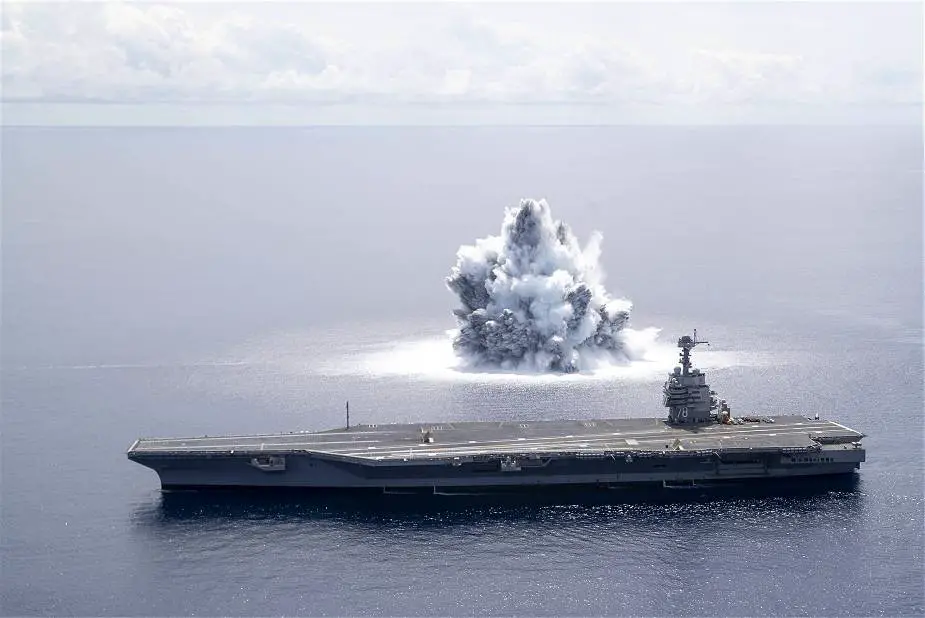According to information published on September 3, 2021, General Atomics Electromagnetic Systems (GA-EMS) announced today that the Electromagnetic Aircraft Launch System (EMALS) and Advanced Arresting Gear (AAG) aboard USS Gerald R. Ford (CVN 78) successfully performed as designed as the ship underwent Full Ship Shock Trials (FSST) off the Eastern seaboard during the months of June, July and August 2021.
Follow Navy Recognition on Google News at this link
 The U.S. Navy aircraft carrier USS Gerald R. Ford (CVN 78) completes the first scheduled explosive event of Full Ship Shock Trials while underway in the Atlantic Ocean, June 18, 2021. (Picture source U.S. DoD)
The U.S. Navy aircraft carrier USS Gerald R. Ford (CVN 78) completes the first scheduled explosive event of Full Ship Shock Trials while underway in the Atlantic Ocean, June 18, 2021. (Picture source U.S. DoD)
The Gerald R. Ford (CVN-78) is the latest generation of aircraft carrier designed and manufactured for the United States Navy and the ship is the successor of the Nimitz-class aircraft carrier design. The design of the Ford-class uses the basic Nimitz-class hull form but incorporates several improvements, including features permitting the ship to generate more aircraft sorties per day, and more electrical power for supporting ship systems. The Gerald R. Ford is the first aircraft carrier in more than three decades to undergo FSST (Full Ship Shock Trials), which provides crucial data for analysis to validate the shock hardness of the ship and all systems aboard to withstand battle conditions.
“The completion of this milestone is a validation of the critical steps we took early in the development process to work closely with the Navy to conduct preliminary shock qualification testing prior to delivering EMALS and AAG equipment to the shipyard for installation,” said Scott Forney, president of GA-EMS (General Atomics Electromagnetic Systems).
GA-EMS actually mount equipment on floating barges and detonate ordnance at various distances and underwater to simulate operation and combat situations. This process allows us to address any issues prior to delivery and installation on the carrier. More importantly, this additional step helps ensure we deliver extremely robust systems to all Ford-class carriers that will provide decades of reliable operational performance under the most challenging conditions.
After completing FSST, CVN 78 enters a six-month Planned Incremental Availability (PIA) period of modernization, maintenance, and repairs. Prior to the recent shock test trials, EMALS and AAG successfully completed various additional milestones during the Post Delivery Trials and Test (PDT&T) period, including the completion of critical Aircraft Compatibility Testing (ACT) and Flight Deck Certification (FDC) involving F/A-18E/F Super Hornets, E-2C/D Hawkeyes and Advanced Hawkeyes, C-2A Greyhounds, EA-18G Growlers, and T-45C Goshawks. At the end of the 18-month PDT&T period, EMALS and AAG successfully achieved and exceeded the Navy’s target of 8,000 launches and recoveries aboard CVN 78.
GA-EMS will continue to work closely with the U.S. Navy to implement system upgrades during the PIA (Planned Incremental Availability) period to meet the ship’s readiness requirements and upcoming deployment schedule. The American-based company will continue to work with the U.S. Navy as installation of these critical technologies moves forward aboard USS John F. Kennedy (CVN 79) and USS Enterprise (CVN 80), and as the Navy determines the production schedule requirements for the USS Doris Miller (CVN 81). The U.S. Navy plans to acquire five Ford-class aircraft carriers including the Gerald R. Ford CVN-78 that was commissioned in July 2017, the John F. Kennedy CVN-79 launched in October 2019, and the Enterprise CVN-80, Doris Miller CN-81, and the CVN-82 that have already been ordered.



